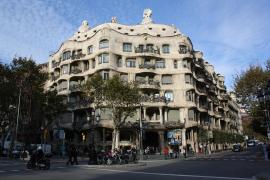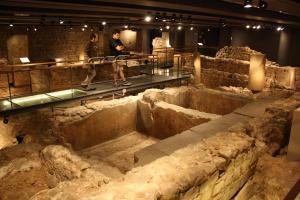By Richard Varr

Roman ruins under Plaça del Rei. Photo by Richard Varr
I walk on raised platforms above the subterranean ruins – crumbling walls, sections of chipped stone columns and carefully-laid mosaic floors amidst rugged walkways and alleys. Historically speaking, however, the ancient stone chambers, streets and squares within Barcelona’s Musea d’História de la Ciutat (City History Museum) are often described as the most extensive and comprehensive underground Roman ruins in the world.

Gaudí’s masterpiece, Casa Milà. Photo by Richard Varr
In the city best known for the genius of Antoni Gaudí’s Modernisme architectural style – undulating walls, colorful chimneys and eye-catching building facades designed with nature’s image in mind – it’s often easy to overlook the City History Museum’s fascinating glimpse of Barcelona’s past in what was once the old Roman city known as Barcino.

Plaça del Rei, where it is believed Columbus was received by royalty upon returning from the New World. Photo by Richard Varr
Located in the central Barri Gòtic or Gothic Quarter, the museum sits adjacent to the 13th and 14th century Royal Palace where, in its medieval courtyard known as the Plaça del Rei, it is believed King Fernando II and Queen Isabel welcomed Christopher Columbus upon his return from the New World. And it’s under this courtyard where the museum’s vast underground ruins lie.

Giant urns used for salting fish. Photo by Richard Varr
Dating back to between the 1st and 6th centuries AD, the ruins were once buildings housing aspects of the Romans’ everyday life. They include a factory where fish was chopped and salted, and a wine-making facility where grapes were pressed and wine fermented in open vats. Hot and cold baths refreshed Roman citizens. Well-defined pits once served as dyeing and laundering centers.

Overlooking the ruins. Photo by Richard Varr
Another important Roman site not particularly obvious to those strolling through the old town are four grand columns that were once part of the landmark Barcino Temple, the dominant structure in the Roman forum, the lively public city square. “This is the most ancient part of Barcelona – the very origin of the city or Barcino,” says tour guide Artur Costa. “The temple was constructed over a hill and was in the center of the forum.”

Four surviving Roman columns from Barcino Temple. Photo by Richard Varr
The columns are housed in a museum of sorts known as the “Temple Roma D’August, Local Dei Centre Excursionista de Catalunya,” standing tall – although chipped and eroded – within an internal courtyard of a medieval mansion. They once supported the back end of Barcino Temple, built in the late first century BC and presiding over the city’s forum for more than four centuries. With the dawn of Christianity in the 5th century AD, the temple lost its importance and its columns were used in the construction of new buildings and palaces.

Richard atop Gaudí’s Casa Batlló with its mosaic chimneys.

Wow, there’s something for the next time I’m in Barcelona. Thanks for sharing =)
Ah, very naughty! When I visited the ruins, there were strict No Photography rules posted at every turn, and guards patrolling wary for the sound of shutters! Good job on sneaking these shots 😀
Thanks for checking out my blog. I don’t recall anyone telling me not to take photos… maybe no flash could be used? But I didn’t have any problems and wasn’t even aware of such a warning… Happy Travels!
I love this post. I went to Paris and to Bath and saw similar ruins. Being a Kiwi and having relatively zero history these sorts of sites blow my mind.
I will have to get to Barcelona one day.
Happy blogging XX Kim
Hi Spiky, thanks for the kind words. Happy travels!
Wow, this post is fantastic, as a Classics student I find all this kind of stuff interesting, I’ll have to see the ruins for myself one day! Great Blog by the way 🙂
Reblogged this on Vista Seekers and commented:
These ruins look fantastic, I hope Lucy and I get to see them one day 😀
I hope you see them as well! Happy travels!
Richard Varr
Pingback: The Best Food I Had In Barcelona And Other Adventures… | Aberrant Crochet (TM)
Hello Everyone I am in Barcelona this week visiting the Roman Ruins and the Drach Caves a must see so please put them on your bucket list. Dr.Willie Dye. http://www.nciba.us
That’s a wonderful post. Thanks.
Thank you for your kind comment, and thanks for visiting my blog!
Pingback: The oldest parts of Barcelona – Don't hold your breath
Wow this is gonna be so exciting. I love visiting Roman ruins.
Pingback: Top 10 Things to See and Do in Barcelona, Spain - David's Been Here